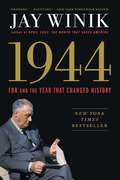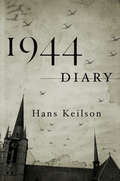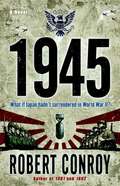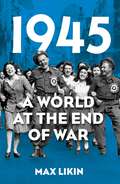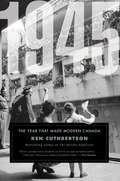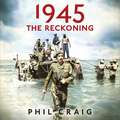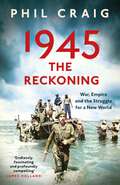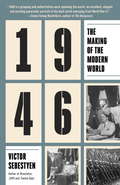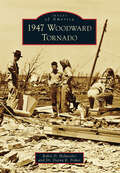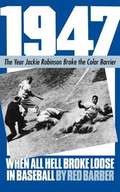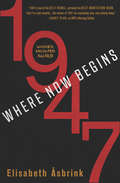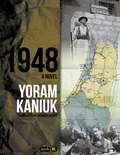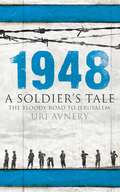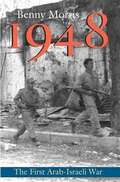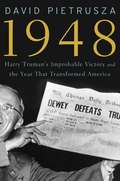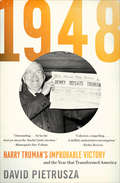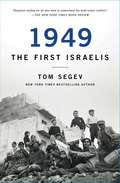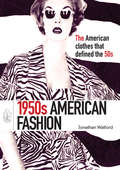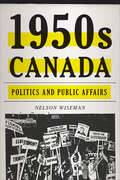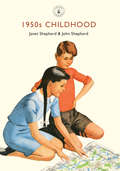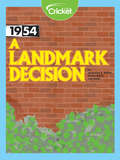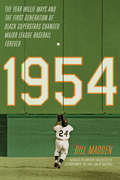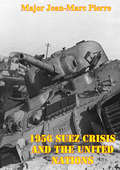- Table View
- List View
1944
by Jay WinikNew York Times bestselling author Jay Winik brings to life in gripping detail the year 1944, which determined the outcome of World War II and put more pressure than any other on an ailing yet determined President Roosevelt.It was not inevitable that World War II would end as it did, or that it would even end well. 1944 was a year that could have stymied the Allies and cemented Hitler's waning power. Instead, it saved those democracies--but with a fateful cost. Now, in a superbly told story, Jay Winik, the acclaimed author of April 1865 and The Great Upheaval, captures the epic images and extraordinary history as never before. 1944 witnessed a series of titanic events: FDR at the pinnacle of his wartime leadership as well as his reelection, the planning of Operation Overlord with Churchill and Stalin, the unprecedented D-Day invasion, the liberation of Paris and the horrific Battle of the Bulge, and the tumultuous conferences that finally shaped the coming peace. But on the way, millions of more lives were still at stake as President Roosevelt was exposed to mounting evidence of the most grotesque crime in history, the Final Solution. Just as the Allies were landing in Normandy, the Nazis were accelerating the killing of millions of European Jews. Winik shows how escalating pressures fell on an all but dying Roosevelt, whose rapidly deteriorating health was a closely guarded secret. Here then, as with D-Day, was a momentous decision for the president. Was winning the war the best way to rescue the Jews? Was a rescue even possible? Or would it get in the way of defeating Hitler? In a year when even the most audacious undertakings were within the world's reach, including the liberation of Europe, one challenge--saving Europe's Jews--seemed to remain beyond Roosevelt's grasp. As he did so brilliantly in April 1865, Winik provides a stunningly fresh look at the twentieth century's most pivotal year. Magisterial, bold, and exquisitely rendered, 1944: FDR and the Year that Changed History is the first book to tell these events with such moral clarity and unprecedented sweep, and a moving appreciation of the extraordinary struggles of the era's outsized figures. 1944 is destined to take its place as one of the great works of World War II.
1944 Diary
by Damion Searls Hans Keilson[1944 Diary] is a deeply personal account, made even more remarkable that it was written during World War II and the horrors of the Holocaust . . . A moving and fascinating read." —Library JournalIn 2010, FSG published two novels by the German- Jewish writer Hans Keilson: Comedy in a Minor Key—written in 1944 while Keilson was in hiding in the Netherlands, first published in German in 1947, and never before in English—and The Death of the Adversary, begun in 1944 and published in 1959, also in German. With their Chekhovian sympathy for perpetrators and bystanders as well as for victims and resisters, Keilson’s novels were, as Francine Prose said on the front page of The New York Times Book Review, “masterpieces” by “a genius” on her list of “the world’s very greatest writers.” Keilson was one hundred years old, alive and well and able to enjoy his belated fame.1944 Diary, rediscovered among Keilson’s papers shortly after his death, covers nine months he spent in hiding in Delft with members of a Dutch resistance group, having an affair with a younger Jewish woman in hiding a few blocks away and striving to make a moral and artistic life for himself as the war and the Holocaust raged around him. For readers familiar with Keilson’s novels as well as those new to his work, this diary is an incomparable spiritual X-ray of the mind and heart behind the art: a record of survival and creativity in what Keilson called “the most critical year of my life.”Offering further insight into Keilson are the sonnets he wrote for his lover, Hanna Sanders, which appear in translation at the back of this volume.
1945: A Novel
by Robert ConroyAmerica has dropped atomic bombs on Hiroshima and Nagasaki.But Japan has only begun to fight. . . .In 1945, history has reached a turning point. A terrible new weapon has been unleashed. Japan has no choice but to surrender. But instead, the unthinkable occurs. With their nation burned and shattered, Japanese fanatics set in motion a horrifying endgame-their aim: to take America down with them. In Robert Conroy's brilliantly imagined epic tale of World War II, Emperor Hirohito's capitulation is hijacked by extremists and a weary United States is forced to invade Japan as a last step in a war that has already cost so many lives. As the Japanese lash out with tactics that no one has ever faced before-from POWs used as human shields to a rain of kamikaze attacks that take out the highest-value target in the Pacific command-the invasion's success is suddenly in doubt. As America's streets erupt in rioting, history will turn on the acts of a few key players from the fiery front lines to the halls of Washington to the shadowy realm of espionage, while a mortally wounded enemy becomes the greatest danger of all.
1945: A World at the End of War
by Max Likin1945 is a fresh look at the last year of the Second World War. Evoking the disorienting strangeness of the end and aftermath of war, it narrates the lives of fifty protagonists caught in the ruins of warfare. The effect is a dazzling kaleidoscope, showing how events affected a wide variety of individuals. From world leaders, artists, writers and musicians to housewives, servicemen and women, concentration camp victims and children, we trace their stories throughout a momentous twelve months. It is a gripping documentary as six years of relentless attrition finally began to come to an end. Written in a fast-moving, impressionistic style, the result is a powerfully evocative and often surprising account, showing how chance and fortune impacted on different people at different times. It will appeal to anyone with an interest in history or military history throughout the world and surprise many with its fascinating juxtapositions of places and people.
1945: The Year That Made Modern Canada
by Ken CuthbertsonIt was a watershed year for Canada and the world. 1945 set Canada on a bold course into the future. A huge sense of relief marked the end of hostilities. Yet there was also fear and uncertainty about the perilous new world that was unfolding in the wake of the American decision to use the atomic bomb to bring the war in the Pacific to a dramatic halt. On the eve of WWII, the Dominion of Canada was a sleepy backwater still struggling to escape the despair of the Great Depression. But the war changed everything. After six long years of conflict, sacrifice and soul-searching, the country emerged onto the world stage as a modern, confident and truly independent nation no longer under the colonial sway of Great Britain. Ken Cuthbertson has written a highly readable narrative that commemorates the seventy-fifth anniversary of the end of WWII and chronicles the events and personalities of a critical year that reshaped Canada. 1945: The Year That Made Modern Canada showcases the stories of people—some celebrated, some ordinary—who left their mark on the nation and helped create the Canada of today. The author profiles an eclectic group of Canadians, including eccentric prime minister Mackenzie King, iconic hockey superstar Rocket Richard, business tycoon E. P. Taylor, Soviet defector Igor Gouzenko, the bandits of the Polka Dot Gang, crusading MP Agnes Macphail, and authors Gabrielle Roy and Hugh MacLennan, among many others. The book also covers topics like the Halifax riots, war brides, the birth of Canada’s beloved social safety net, and the remarkable events that sparked the Cold War. 1945 is the unforgettable story of our nation at the moment of its modern birth.
1945: War, Empire and the Struggle for a New World
by Phil CraigAs the fate of the world is decided, so too is that of the British, Dutch and French empires. In India a generation committed to independence must decide whether to support 'the Raj' or fight alongside the Japanese. One military family is bitterly divided. Will it be the brother who serves under British command, or the one who follows Subhas Chandra Bose and his Indian National Army, who goes on to help build a new and free India? In Borneo a little known Australian special forces campaign - secretly controlled from London - goes horribly wrong as questions are asked about whether its true purpose is military or imperial. And in Indochina and the East Indies British Generals free and arm Japanese prisoners of war and use them in savage campaigns that aim to put colonial rulers back into their palaces.Clearing away the haze of nostalgia, many uncomfortable truths emerge - but so too does a humane and balanced exploration of what victory in the Second World War truly means.
1945: War, Empire and the Struggle for a New World
by Phil CraigAs the fate of the world is decided, so too is that of the British, Dutch and French empires. In India a generation committed to independence must decide whether to support 'the Raj' or fight alongside the Japanese. One military family is bitterly divided. Will it be the brother who serves under British command, or the one who follows Subhas Chandra Bose and his Indian National Army, who goes on to help build a new and free India? In Borneo a little known Australian special forces campaign - secretly controlled from London - goes horribly wrong as questions are asked about whether its true purpose is military or imperial. And in Indochina and the East Indies British Generals free and arm Japanese prisoners of war and use them in savage campaigns that aim to put colonial rulers back into their palaces.Clearing away the haze of nostalgia, many uncomfortable truths emerge - but so too does a humane and balanced exploration of what victory in the Second World War truly means.
1946: The Making of the Modern World
by Victor SebestyenFrom the author of Twelve Days: The Story of the 1956 Hungarian Revolution and Revolution 1989: The Fall of the Soviet Empire comes a powerful, revelatory book about the year that would signal the beginning of the Cold War, the end of the British Empire, and the beginning of the rivalry between the United States and the USSR. Victor Sebestyen reveals the events of 1946 by chronologically framing what was taking place in Europe, the Middle East, and Asia, with seminal decisions made by heads of state that would profoundly change the old order forever. Whether it was the July 22 bombing of the King David Hotel in Jerusalem, the July 25 Bikini Atoll underwater atomic bomb test, or the August 16 Great Calcutta Killings in India, 1946 was a year of seismic and dramatic events. Sebestyen begins with the Moscow Foreign Ministers' Conference the week before Christmas 1945, when Stalin announced that the USSR would not withdraw its troops from Iran by March 1946, and ends with the morning of November 3, 1946, when Emperor Hirohito officially unveiled Japan's new constitution before the National Diet. The year 1946 would see the map of Eastern Europe redrawn, Chinese communists gaining decisive victories in their fight for power, and the birth of Israel. Though Truman, Stalin, Churchill, MacArthur, Ben-Gurion, Hirohito, and Menachem Begin are part of the story, Sebestyen also writes about the enormous suffering and ongoing persecution of civilians in the aftermath of the war: the pillaging and rape; the ethnic cleansing of the German population from Czechoslovakia and Poland; the rise of a violent new anti-Semitism; the civil wars in China and Greece; the mass starvation in Japan, Eastern Europe, and Germany on a scale not seen since the Middle Ages; the spread of diseases such as tuberculosis and diphtheria; and such total desolation that schools, government, and transportation were nonexistent and currency was worthless. Drawing on personal testimonies and new archival research, Sebestyen has written a vivid and compelling narrative that brilliantly evokes the beginning of the Cold War set against a devastated landscape of dystopian horrors.(With 16 pages of black-and-white photographs.)From the Hardcover edition.
1947 Ke Zakhma: १९४७ के ज़ख्म
by Rajeev Shuklaवर्ष 1947 में भारत-विभाजन के सात दशक से अधिक बीत जाने पर भी इस पीड़ा से गुजरे लोगों का दिलो-दिमाग आज भी इस दुःख का बोझ उठाए हुए है। नक्शे पर स्याही के बस एक निशान ने एक देश को दो में बाँट दिया, जिसका प्रभाव न केवल एक पीढ़ी पर, बल्कि आने वाली कई पीढि़यों पर भी पड़ा। इससे मिले ज़ख़्म आज भी अंदर तक पीड़ा देते हैं। भारत और पाकिस्तान को बाँटने वाली खौफनाक रेडक्लिफ रेखा के दोनों तरफ के लोगों ने अकल्पनीय त्रासदियों को झेला। लाखों लोगों के विस्थापन के कारण घटी भयानक घटनाएँ इस दुस्वप्न को भोग चुके लोगों की यादों को हमेशा कचोटती रहेंगी। हाँ, बड़े पैमाने पर बरबादी के बावजूद सब खो देने और सबकुछ गँवा बैठने के बीच उत्साहित करने वाली मानवीयता, साहस और दृढ़-संकल्प की कुछ कहानियाँ भी हैं। ये ऐसे लोगों की कहानियाँ हैं, जो प्रधानमंत्री, राष्ट्रपति, उद्योगपति, चिकित्सा-शोधार्थी तथा और भी बहुत-कुछ बने। विभाजन के बाद के दशकों में परिवारों की शून्य से शुरुआत कर फिर से जीवन-निर्माण करने की ये कहानियाँ याद रखने योग्य एवं प्रेरणादायी हैं। इन कहानियों में मनमोहन सिंह और मोहम्मद अली जिन्ना से लेकर गौरी खान की नानी और अवतार नारायण गुजराल तक आते हैं। ‘1947 के ज़ख़्म’ बीते समय की यात्रा का रोमांचक और भावुकतापूर्ण संकलन है। वह अविस्मरणीय समय था, जो दोनों देशों पर हमेशा के लिए निशान छोड़ गया।
1947 Woodward Tornado (Images of America)
by Robin D. Hohweiler Dr. Deena FisherThe 1947 Woodward Tornado remains the deadliest tornado in Oklahoma history, leaving more than 100 people dead and nearly 1,000 seriously injured. The tornado struck the city of Woodward under cover of darkness and without warning at 8:42 p.m. on April 9, 1947. The storm left in its wake hundreds of stories of tragic loss, devastation, and even mysteries that remain unsolved. These include the three unidentified girls--one as young as six months--whose bodies have remained unclaimed, as well as the mystery of what happened to Joan Gay Croft, a girl who disappeared from the local hospital on the night of the storm. Croft's disappearance was featured in an episode of the television show Unsolved Mysteries in the early 1990s. There is also the oft-overlooked story of those who took up residence (some for more than a year) in "Tornado Town" west of the city and found some glimmer of hope in an otherwise hopeless situation.
1947: When All Hell Broke Loose in Baseball
by Red BarberThis is a great baseball story and an even better one about a crucial moment in American history. When Jackie Robinson was penciled into the lineup for the Brooklyn Dodgers in 1947, America's national pastime and America's future changed forever. How much is reflected in a remark Martin Luther King, Jr. made to Don Newcombe: "You'll never know what you and Jackie and Roy did to make it possible to do my job." Red Barber was perfectly situated to observe this drama. Broadcaster for the Dodgers, friend of Branch Rickey who confided in him before and during the year of decision, and keen student of the game and the behavior of its players, Red held the microphone as the story unfolded with a cast of characters that included baseball immortals Duke Snyder, Leo Durocher, Pee Wee Reese, Pete Reiser, Larry McPhail and Joe DiMaggio. Towering above them all are Jackie Robinson and Branch Rickey, who together made baseball and American history and whose courage and toughness Red Barber captures so beautifully in this book.
1947: Where Now Begins
by Fiona Graham Elisabeth ÅsbrinkAn award-winning writer captures a year that defined the modern world, intertwining historical events around the globe with key moments from her personal history.The year 1947 marks a turning point in the twentieth century. Peace with Germany becomes a tool to fortify the West against the threats of the Cold War. The CIA is created, Israel is about to be born, Simone de Beauvoir experiences the love of her life, an ill George Orwell is writing his last book, and Christian Dior creates the hyper-feminine New Look as women are forced out of jobs and back into the home. In the midst of it all, a ten-year-old Hungarian-Jewish boy resides in a refugee camp for children of parents murdered by the Nazis. This year he has to make the decision of a lifetime, one that will determine his own fate and that of his daughter yet to be born, Elisabeth.
1948
by Yoram Kaniuk Anthony BerrisSixty years after fighting in Israel's War of Independence, Yoram Kaniuk tries to remember what exactly did--and did not--happen in his time as a teenage soldier in the Palmach. The result is a touchingly poignant and hauntingly beautiful memoir that the author himself considers a work of fiction, for what is memory but one's own story about the past? Eschewing self-righteousness in favor of self-criticism, Kaniuk's book, winner of the 2010 Sapir Prize for Literature, is the tale of a younger man told by his older, wiser self--the self who realizes that wars are pointless, and that he and his friends, young men from good homes forming an offbeat band of brothers, were senseless to see glory in the prospect of dying young. But it is also a painful, shocking, and tragically relevant homage to the importance of bearing witness to the follies of the past, even--or especially--when they are one's own.
1948. A Soldier's Tale The Bloody Road to Jerusalem: A Soldier's Tale - The Bloody Road to Jerusalem
by Uri AvneryThe first eye-witness account ever published of the 1948 Israeli War of Independence, this riveting memoir of a young Israeli soldier became an instant bestseller on publication in 1949, and is still recognized as the outstanding book of that war, in the tradition of Erich Maria Remarque's All Quiet on the Western Front. First joining the Givati Brigade and later volunteering for "Samson's Foxes", the legendary commando unit, Avnery took part in almost all the major battles on the Jerusalem and southern fronts. Written from the trenches, and from a military hospital bed, he offers an extraordinarily detailed account of the war, of fast-paced battles, and acts of extreme bravery, as well as the camaraderie and off-duty exploits of young men and women thrust into the front line. This is a gripping, sensitive, and at times deeply poignant account of the day-to-day brutalities of one of the most significant wars of our times.
1948: A History Of The First Arab-israeli War
by Benny MorrisThis history of the foundational war in the Arab-Israeli conflict is groundbreaking, objective, and deeply revisionist. A riveting account of the military engagements, it also focuses on the war's political dimensions. Benny Morris probes the motives and aims of the protagonists on the basis of newly opened Israeli and Western documentation. The Arab side-where the archives are still closed-is illuminated with the help of intelligence and diplomatic materials. Morris stresses the jihadi character of the two-stage Arab assault on the Jewish community in Palestine. Throughout, he examines the dialectic between the war's military and political developments and highlights the military impetus in the creation of the refugee problem, which was a by-product of the disintegration of Palestinian Arab society. The book thoroughly investigates the role of the Great Powers-Britain, the United States, and the Soviet Union-in shaping the conflict and its tentative termination in 1949. Morris looks both at high politics and general staff decision-making processes and at the nitty-gritty of combat in the successive battles that resulted in the emergence of the State of Israel and the humiliation of the Arab world, a humiliation that underlies the continued Arab antagonism toward Israel.
1948: Harry Truman's Improbable Victory and the Year that Transformed America
by David PietruszaThe behind-the-headline true story of Harry Truman's stunning upset! Everyone knows the iconic news photo of jubilant underdog Harry Truman brandishing a copy of the Chicago Tribune proclaiming "DEWEY DEFEATS TRUMAN. " David Pietrusza goes backstage to explain how it happened, placing the brutal political battle in the context of an erupting Cold War and America's exploding storms over civil rights and domestic communism. Pietrusza achieves for 1948's presidential race what he previously did in his acclaimed 1960--LBJ vs. JFK vs. Nixon: bringing history to life and intrigue readers with tales of high drama while simultaneously presenting the issues, personalities, and controversies of this pivotal era with laser-like clarity.
1948: Harry Truman's Improbable Victory and the Year that Transformed America
by David PietruszaThe wild, combative inside story of the most stunning upset in the history of presidential elections—Harry Truman's victory over Tom Dewey: &“Outstanding.&”—Minneapolis Star-Tribune In this lively account, award-winning historian David Pietrusza unpacks the most ingloriously iconic headline in the history of presidential elections—DEWEY DEFEATS TRUMAN—to reveal the 1948 campaign's backstage events and recount the down-to-the-wire brawl fought against the background of an erupting Cold War, the Berlin Airlift, the birth of Israel, and a post-war America facing exploding storms over civil rights and domestic communism. &“Coherent, compelling…A skillful, authoritative investigation.&”—Kirkus Reviews &“A terrific book…a must-read.&”—Ron Faucheux, former editor-in-chief, Campaigns & Elections magazine &“Brilliantly portrays President Harry Truman's successful efforts to stave off the challenge of New York Gov. Tom Dewey, who was making a repeat bid as the Republican nominee.&”—David Mark, author of Going Dirty: The Art of Negative Campaigning &“Sweeping…compelling.&”—Library Journal &“Gripping detail.&”—The New York Journal of Books
1949 the First Israelis: The First Israelis
by Tom SegevRenowned historian Tom Segev strips away national myths to present a critical and clear-eyed chronicle of the year immediately following Israel’s foundation.“Required reading for all who want to understand the Arab-Israeli conflict…the best analysis…of the problems of trying to integrate so many people from such diverse cultures into one political body” (The New York Times Book Review). Historian and journalist Tom Segev stirred up controversy in Israel upon the first publication of 1949. It was a landmark book that told a different story of the country’s early years, one that wasn’t taught in schools or shown in popular culture. Rather than painting the idealized picture of the Israel’s founding in 1948, after the wreckage of the Holocaust, Segev reveals gritty underside behind the early years. The new country of Israel faced challenges on all sides. Day-to-day life was severe, marked by austerity and food shortages; Israeli society was fractured between traditional and secular camps; Jewish immigrants from Middle-Eastern countries faced discrimination and second-class treatment; and clashes between settlers and the Arabs would set the tone for relations for the following decades, hardening attitudes and creating a violent cycle of retaliation. Drawing on journal entries, letters, declassified government documents, and more, 1949 is a richly detailed look at the friction between the idealism of the Zionist movement and the cold realities of history. Decades after its publication in the United States, Segev’s groundbreaking book is still required reading for anyone who wants to understand Israel’s past and future.
1950s American Fashion
by Jonathan WalfordThe 1950s was the first decade when American fashion became truly American. The United States had always relied on Europe for its style leads, but during World War II, when necessity became the mother of invention, the country had to find its own way. American designers looked to what American women needed and found new inspirations for American fashion design. Sportswear became a strength, but not at the expense of elegance. Easy wear materials were borrowed for producing more formal clothes, and versatile separates and adaptable dress and jacket suits became hallmarks of American style. This book follows the American fashion industry, from New York's 7th Avenue to the beaches of California in search of the clothes that designed 1950s American fashion.
1950s Canada: Politics and Public Affairs
by Nelson WisemanWhile the 1950s in Canada were years of social conformity, it was also a time of political, economic, and technological change. Against a background of growing prosperity, federal and provincial politics became increasingly competitive, intergovernmental relations became more contentious, and Canada’s presence in the world expanded. The life expectancy of Canadians increased as the social pathologies of poverty, crime, and racial, ethnic, and gender discrimination were in retreat. 1950s Canada illuminates the fault lines around which Canadian politics and public affairs have revolved. Chronicling the themes and events of Canadian politics and public affairs during the 1950s, Nelson Wiseman reviews social, economic, and cultural developments during each year of the decade, focusing on developments in federal politics, intergovernmental relations, provincial affairs, and Canada’s role in the world. The book examines Canada’s subordinate relationship first with Britain and then the United States, the interplay between Quebec’s distinct society and the rest of Canada, and the regional tensions between the inner Canada of Ontario and Quebec and the outer Canada of the Atlantic and western provinces. Through this record of major events in the politics of the decade, 1950s Canada sheds light on the rapid altering of the fabric of Canadian life.
1950s Childhood
by Janet ShepherdThe generation who grew up in Britain immediately after the Second World War are popularly called 'The Baby Boomers'. As children, they experienced life in Britain from wartime austerity to the relative affluence of the late 1950s. Uniquely healthier and wealthier than previous generations, this first welfare state generation received free orange juice, milk and cod liver oil to safeguard their health. However, their overall diet was restricted until rationing fully ended in 1954 - and the permissive society had yet to arrive. Janet and John Shepherd explore how the Baby Boomers grew up through the change from post-war restrictions to a new consumer society, enjoying increased choice in the shops, while at home, pirate Radio Luxembourg and flickering black and white television opened up new vistas.
1954: A Landmark Decision
by Jacqueline B. WalkerIn the 1950s, African Americans leaders used the nation's laws and courts to confirm black citizens' rights. This article explores how America's schools finally became desegregated.
1954: The Year Willie Mays and the First Generation of Black Superstars Changed Major League Baseball Forever
by Bill Madden1954: Perhaps no single baseball season has so profoundly changed the game forever. In that year#151;the same in which the US Supreme Court unanimously ruled, in the case of Brown vs. Board of Education, that segregation of the races be outlawed in America's public schools#151;Larry Doby's Indians won an American League record 111 games, dethroned the five-straight World Series champion Yankees, and went on to play Willie Mays's Giants in the first World Series that featured players of color on both teams. Seven years after Jackie Robinson had broken the baseball color line, 1954 was a triumphant watershed season for black players#151;and, in a larger sense, for baseball and the country as a whole. While Doby was the dominant player in the American League, Mays emerged as the preeminent player in the National League, with a flair and boyish innocence that all fans, black and white, quickly came to embrace. Mays was almost instantly beloved in 1954, much of that due to how seemingly easy it was for him to live up to the effusive buildup from his Giants manager, Leo Durocher, a man more widely known for his ferocious "nice guys finish last" attitude. Award-winning, New York Times bestselling author Bill Madden delivers the first major book to fully examine the 1954 baseball season, drawn largely from exclusive recent interviews with the major players themselves, including Mays and Doby as well as New York baseball legends from that era: Yogi Berra and Whitey Ford of the Yankees, Monte Irvin of the Giants, and Carl Erskine of the Dodgers. 1954 transports readers across the baseball landscape of the time#151;from the spring training camps in Florida and Arizona to baseball cities including New York, Baltimore, Chicago, and Cleveland#151;as future superstars such as Hank Aaron, Ernie Banks, and others entered the leagues and continued to integrate the sport. Weaving together the narrative of one of baseball's greatest seasons with the racially charged events of that year, 1954 demonstrates how our national pastime#151;with the notable exception of the Yankees, who represented "white supremacy" in the game#151;was actually ahead of the curve in terms of the acceptance of black Americans, while the nation at large continued to struggle with tolerance.
1956 Suez Crisis And The United Nations
by Major Jean-Marc PierreThe 1956 Suez Crisis is the first example of a pre-emptive strike after World War II. The episode provides lessons about the lengths to which nations will go to secure their interests and the limits of the United Nation's influence. How the UN uses its power is the point of contention. In 1956, Great Britain, France, and Israel believed the organization would protect their security interests through the unbiased maintenance of international law. Yet, as common in the Cold War, UN action was hampered. A war began and ended with a cease-fire in fifty-five hours. Three militarily superior armies won their tactical fights but were strategically defeated. Most notably, the influence of global authority shifted to the superpowers. Through all this, the UN changed its mission and purpose. The primary question therefore is did the UN resolve the 1956 Suez Crisis? Resolution had to include a status quo ante bellum, the return to the existing system before the war, or the recognition of a new international Regime. The UN's ability to resolve such crises directly affects its legitimacy in the international community.
